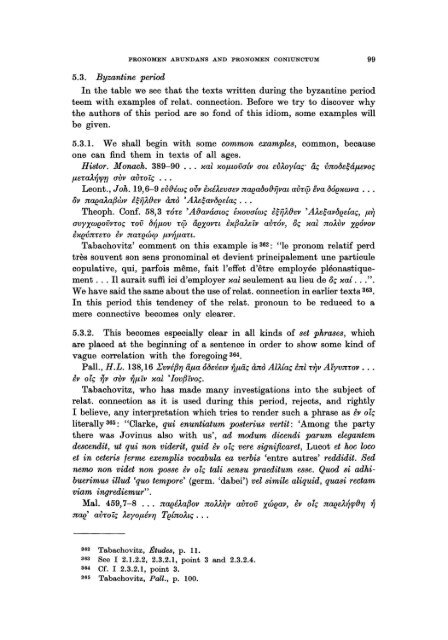Pronomen Abundans and Pronomen Coniunctum. A ... - DWC
Pronomen Abundans and Pronomen Coniunctum. A ... - DWC
Pronomen Abundans and Pronomen Coniunctum. A ... - DWC
You also want an ePaper? Increase the reach of your titles
YUMPU automatically turns print PDFs into web optimized ePapers that Google loves.
5.3. Byzantine period<br />
PRONOMEN ABUNDANS AND PRONOMEN CONIUNCTUM 99<br />
In the table we see that the texts written during the byzantine period<br />
teem with examples of relat. connection. Before we try to discover why<br />
the authors of this period are so fond of this idiom, some examples will<br />
be given.<br />
5.3.l. We shall begin with some common examples, common, because<br />
one can find them in texts of all ages.<br />
Histor. Monach. 389-90 ... "at "of-lwvalv aot eVÀoylaç aç vnode~áf-levoç<br />
f-le-caÀ~"Pn avv av-coiç ...<br />
Leont., Joh. 19,6-9 eVf}iwç oVv i"ÉÀevaev naeadofHjvat avnp lva Mf!xwva ...<br />
IJv naf!aÀaf3wv i~ijMhv &nd ' AÀe~avdf!daç ...<br />
Theoph. Conf. 58,3 -cóu ' A~aváawç é"ovalwç i~ijÀ~ev ' AÀe~avdf!elaç, f-l-YJ<br />
avyxwf!OVV-COç -cov d~f-loV up aexovn i"f3aÀeïv av-cóv, öç "ai noÀvv xeóvov<br />
i"evnu-co iv na-cewo/ f-lv~f-lan.<br />
Tabachovitz' comment on this example is 362: "Ie pronom relatif perd<br />
très sou vent son sens pronominal et devient principalement une particule<br />
copulative, qui, parfois même, fait l'effet d'être employée pléonastiquement<br />
... Il aurait suffi ici d'employer "ai seulement au lieu de öç "al . . .".<br />
We have said the same about the use ofrelat. connection in earlier texts 363.<br />
In this period this tendency of the relat. pronoun to be reduced to a<br />
mere connective becomes only clearer.<br />
5.3.2. This becomes especially clear in all kinds of set phrases, which<br />
are placed at the beginning of a senten ce in order to show some kind of<br />
vague correlation with the foregoing 364.<br />
Pall., H.L. 138,16 EvvÉf3'YJ äpa ódev8lv ~f-läç &nd AWaç int -c-YJv Ai'yvn-cov . ..<br />
iv olç 1}"v avv ~f-liv "ai ' Iovf3ivoç.<br />
Tabachovitz, who has made many investigations into the subject of<br />
relat. connection as it is used during this period, rejects, <strong>and</strong> rightly<br />
I believe, any interpretation which tries to render such a phrase as iv olç<br />
literally 365: "Clarke, qui enuntiatum posterius vertit: 'Among the party<br />
there was Jovinus also with us', ad modum dicendi parum elegantem<br />
descendit, ut qui non viderit, quid iv olç vere significaret, Lucot et hoc loco<br />
et in ceteris ferme exemplis vocabula ea verbis 'entre autres' reddidit. Sed<br />
nemo non videt non posse èv olç tali sensu praeditum esse. Quod si adhibuerimus<br />
illud 'quo tempore' (germ. 'dabei') vel simile aliquid, quasi rectam<br />
viam ingrediemur" .<br />
Mal. 459,7-8 ... naeüaf30v nOAA-YJv av-cov XWf!av, iv olç naeeA~CP{}'YJ ~<br />
nae' av-coiç Àeyof-lÉv1] TelnoÀtç ...<br />
862 Tabachovitz, Étude8, p. Il.<br />
363 See I 2.1.2.2, 2.3.2.1, point 3 <strong>and</strong> 2.3.2.4.<br />
364 Cf. I 2.3.2.1, point 3.<br />
365 Tabachovitz, Pall., p. 100.
















